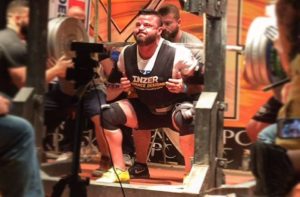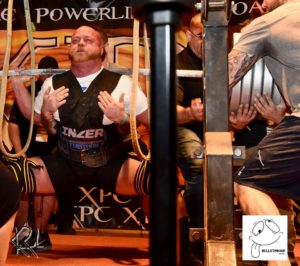
29 Jan The Pause Squat
By: Will Kuenzel
Squatting can be as complicated as we want it to be. For as simple as sitting down and standing back up can be, to really maximize the potential we start to look at the details. It’s within these details that we start to analyze our weaknesses and try to make adjustments to our training so that we can improve upon these areas. As with the 10/20/Life philosophy, addressing the weak points should be your biggest concern. Getting strong but not addressing the things holding you back will never allow for progress to continue. Taking this into consideration when looking at the squat and we start talking about position coming out of the bottom.
[wa-wps]Even before we start talking about speed, muscle groups to start the ascent, or anything else…position is the first thing to look into. Great glute firing out of the bottom means little if the upper back is rounded and your head is down. You have to be in the best position possible to start coming out of the bottom. Proper position in, and coming out of, the bottom helps insure a higher probability of success. This where the pause squat comes in handy.
How Should You Pause Squat?
A simple pause squat is treated very similar to a normal squat. Treat the set up and descent just the same. Once you reach the bottom of the squat, you’ll pause for a pre-determined amount of time. This time varies depending on what we’re trying to accomplish. Once the pause has ended, without bouncing or rocking, make your normal ascent. Simple. Yet still I see folks mess this up. From doing a “pause” squat with no pause, to bouncing at the bottom during the “pause”, to even once the pause is over, bouncing or rocking again to get moving. Stop this. It’s a PAUSE squat. No motion. Get the technique down first and understand why you’re doing them.
How To Use Pause Squats
We’re using these to re-enforce proper technique. So when using these I will tell clients/athletes if technique falls off, you’ve exceeded the RPE. We use pause squats to teach awareness and muscle control under load. The weight should be light enough that during the pause you can respond to verbal queuing. If you cannot address issues mid-pause then the weight is too heavy. The weight should be heavy enough to be challenging for the last couple reps of the sets. Things drastically change under load. As the pressure builds in your head, thinking about what you need to do is tough. Regardless, you’ve got to be able to adjust as necessary. It helps to have somebody count out loud for you for. Our perception of time changes when we are uncomfortable. Two seconds of something we enjoy goes by all too quickly. However, two seconds while under a crushing load, well, that seems like an eternity. Probably a good reason why most folks’ pause squats aren’t really that paused.
When To Use Pause Squats
As Brian talks about in the 10/20/Life book, pause squats are useful for those folks missing out of the bottom. I’ll also use these to get folks more comfortable in the bottom for those that have a hard time getting to and breaking parallel. Besides just getting comfortable reaching proper depth, there’s also the idea of maintaining proper position while there and in the transition out of it. Also, the transition out of the bottom is one of the key elements in the pause squat.
Do not let form or technique deviate from how it is supposed to be. Besides doing these like cutting the pause short or trying to bounce out of the bottom after the pause, letting the knees collapse or rounding of the back out of the bottom is not helping the reinforcement of a proper muscular/neural pattern. As I remind my clients and athletes on a daily basis, “practice makes permanent.” If even while pause squatting, you are performing a movement poorly, what do you think is going to happen? Things are magically fixed at a meet or during competition? Usually it’s the opposite, at a meet is where all things go wrong. Use training to minimize that chance.
Variations Of The Pause Squat
I’m very much a fan of using pause squats to build proper technique. By themselves I don’t use them as massive strength builders. Typical loads to perform them properly just don’t allow for a tremendous amount of strength to be built. They’re utilized to work weak points, and when addressing weak areas, weights will typically be lighter. Especially in an effort to reinforce a positive movement pattern. I will, however, add chains or bands depending on the individual and they’re particular style of lifting. Brian Carroll and Scott Paltos talk about speedsters and grinders. I’m more of a speedster. Things pop and pop quickly for me. I don’t grind well. In this case, I’ll use more chains for myself. At the very bottom of the squat, the chains should be completely deloaded. (
As a side bar – please learn to use chains properly! They deload at the bottom of the lift. They don’t have to be, and is usually preferable if they aren’t, completely off the floor at the top of the lift.
For those grinders though, bands work well. Lighter loads and just enough band tension that when you move fast, you don’t even feel the bands. Mess up and try to grind it and the bands kick up quick and you have problems. One of my recent squatting sessions, I was doing some banded box squats. Things were going well and I took the weight for granted. I got slapped back down on my ass for not driving like I was supposed to.
Besides bands or chains, variations of where the lift is paused can also be done. For my lifters comfortable in the hole, I’ll have them pause just slightly out of it, right above parallel where some tend to get caught forward. A lifter should try to think about activating the lats to hold a tight position while slightly above parallel. This is a great idea for those that get caught falling forward. This helps to keep position and find the best position and queue to keep the lift moving.
The beauty of lifting is that there are dozens of different ways of doing everything. These are some of the things that have worked really well for myself and some of the folks I have trained. It’s also to say that none of this is set in stone. The variations of the pause or the use of chains or bands will help if it’s used to address the appropriate weakness. Using something for the sake of using it is senseless and pointless. Everything must be used for a reason so that it has a beneficial response. Know the weakness and know how to address it appropriately.
Low Country Strength
Latest posts by Low Country Strength (see all)
- LCS Off Season Week 7, Session 1-3 - February 20, 2019
- LCS Off Season Week 6, Session 1-3 - February 20, 2019
- LCS Off Season Week 5, Session 1-2 - February 20, 2019







Sorry, the comment form is closed at this time.